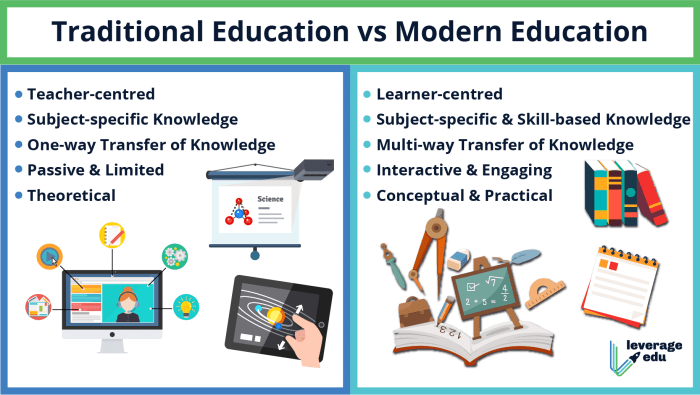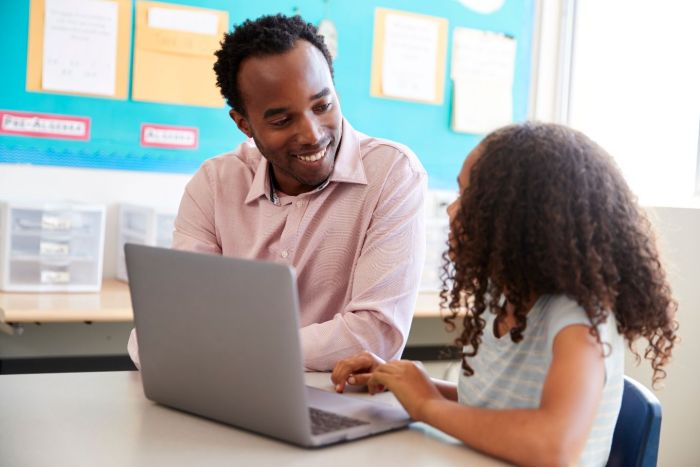The impact of technology on traditional education sets the stage for this enthralling narrative, offering readers a glimpse into a story that is rich in detail with idntimes author style and brimming with originality from the outset.
Technology’s rapid evolution has fundamentally changed the landscape of traditional education, ushering in a new era of innovation and possibilities for both students and educators alike.
The Benefits of Technology in Education

Technology has significantly transformed the landscape of education, offering numerous benefits to both students and educators. From improved access to educational resources to enhanced learning experiences, technology plays a crucial role in shaping the future of education.
Improved Access to Educational Resources
- Technology has made it easier for students to access a wide range of educational materials online, including textbooks, articles, videos, and interactive simulations.
- Online platforms and digital libraries provide students with the opportunity to explore a variety of resources, regardless of their geographical location or financial constraints.
- Virtual classrooms and online courses enable students to learn at their own pace and convenience, breaking down barriers to traditional education.
Enhanced Learning Experience for Students
- Technology allows for personalized learning experiences tailored to individual student needs and learning styles.
- Interactive educational tools, such as educational apps and gamified learning platforms, make learning more engaging and enjoyable for students.
- Virtual reality (VR) and augmented reality (AR) technologies create immersive learning environments that enhance student comprehension and retention of information.
Promoting Interactive and Engaging Learning Environments
- Collaborative online platforms and tools facilitate communication and teamwork among students, promoting a sense of community and collaboration.
- Interactive whiteboards, polling apps, and online quizzes encourage active participation and engagement in classroom activities.
- Technology enables educators to integrate multimedia elements, such as videos, animations, and simulations, into their lessons to make learning more dynamic and interactive.
Challenges of Integrating Technology in Traditional Education: The Impact Of Technology On Traditional Education

Integrating technology in traditional education comes with its own set of challenges that educators need to address. From resistance to change to the digital divide, there are various hurdles that need to be overcome to successfully implement technology in the classroom.
Resistance Faced by Educators
Educators often face resistance when it comes to adopting technology in their teaching practices. Some teachers may feel overwhelmed by the idea of incorporating new tools and methods into their curriculum. Additionally, there may be a lack of training and support for educators to effectively integrate technology into their teaching.
Discover how Benefits of vocational education programs has transformed methods in this topic.
Impact of Technology on Traditional Teaching Methods
The introduction of technology in traditional education has disrupted traditional teaching methods. While technology can enhance learning experiences and make education more interactive and engaging, it can also challenge the traditional roles of educators. Teachers may need to adapt their teaching styles to accommodate technology and ensure that students are still receiving a well-rounded education.
The Digital Divide
The digital divide refers to the gap between those who have access to technology and those who do not. This gap can significantly impact the integration of technology in education, as students without access to technology may be at a disadvantage. It is crucial for educators to address the digital divide and ensure that all students have equal opportunities to benefit from technology in the classroom.
Innovative Technological Tools Transforming Education
Technology continues to revolutionize education, offering new and exciting ways to engage students and enhance learning outcomes. Innovative tools such as virtual reality, augmented reality, artificial intelligence, online platforms, and learning management systems are transforming traditional education methods.
Virtual Reality and Augmented Reality in the Classroom
Virtual reality (VR) and augmented reality (AR) are immersive technologies that have the potential to revolutionize the way students learn. By creating realistic and interactive environments, VR and AR can transport students to different locations, eras, or scenarios, providing a hands-on learning experience that is both engaging and memorable.
- VR and AR can be used to simulate complex concepts in subjects like science, history, and geography, allowing students to explore and interact with virtual objects.
- These technologies can also enhance creativity and problem-solving skills by enabling students to design and manipulate 3D objects in a virtual space.
- By making learning more interactive and visually stimulating, VR and AR can cater to different learning styles and improve retention rates.
Artificial Intelligence in Personalized Learning Experiences
Artificial intelligence (AI) plays a crucial role in personalized learning experiences by analyzing student data and adapting instruction to meet individual needs. AI-powered tools can track student progress, identify learning gaps, and provide targeted feedback, creating a customized learning path for each student.
- AI can recommend personalized learning resources based on students’ strengths and weaknesses, helping them focus on areas that need improvement.
- These tools can also provide real-time feedback on assignments and assessments, allowing students to track their progress and make adjustments accordingly.
- By leveraging AI, educators can create adaptive learning environments that cater to the unique needs and pace of each student, ultimately enhancing their learning experience.
Online Platforms and Learning Management Systems for Educational Outcomes, The impact of technology on traditional education
Online platforms and learning management systems (LMS) have transformed the way education is delivered and accessed, offering a wide range of resources and tools to support teaching and learning.
- These platforms enable educators to deliver content, assignments, and assessments online, making learning more accessible and flexible for students.
- LMS provide a centralized hub for course materials, communication tools, and collaboration features, facilitating seamless interaction between students and instructors.
- Online platforms offer opportunities for blended learning, where traditional classroom instruction is combined with online resources to create a more engaging and interactive learning experience.
The Future of Traditional Education in a Technology-Driven World

In a rapidly evolving world driven by technology, the future of traditional education is inevitably intertwined with the advancements in digital tools and resources. As we look ahead, it is crucial to analyze how technology will continue to shape the landscape of education, both in terms of benefits and challenges.
Potential Benefits of a Fully Technology-Integrated Educational System
- Enhanced Accessibility: Technology can provide access to education for students in remote areas or those with physical limitations.
- Personalized Learning: Adaptive learning platforms can cater to individual student needs and pace of learning.
- Global Collaboration: Virtual classrooms and online communication tools enable students to connect with peers worldwide, fostering a sense of global citizenship.
- Interactive Learning: Immersive technologies like virtual reality can create engaging and interactive learning experiences for students.
Drawbacks of a Fully Technology-Integrated Educational System
- Digital Divide: Socioeconomic disparities can lead to unequal access to technology, exacerbating educational inequities.
- Overreliance on Technology: Excessive use of technology may hinder critical thinking skills and face-to-face interaction among students.
- Data Privacy Concerns: The collection and storage of student data by educational technology companies raise privacy and security issues.
- Teacher Training: Educators may require additional training to effectively integrate technology into their teaching practices.
Role of Technology in Preparing Students for Future Careers and Digital Literacy
- Skills Development: Technology helps students acquire essential digital skills needed for the workforce, such as coding, data analysis, and digital communication.
- Adaptability: Exposure to various technological tools prepares students to navigate changing job markets and industries.
- Critical Thinking: Technology integration encourages students to think critically, problem-solve, and innovate in a digital environment.
- Lifelong Learning: Continuous access to online resources and educational platforms promotes lifelong learning and skill development beyond traditional classroom settings.